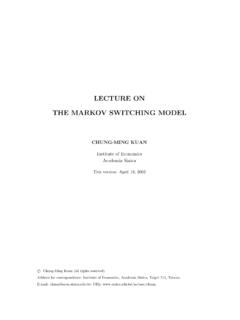Transcription of Chapter 7
1 Chapter 7 Net Present Value and Other Investment Criteria7- 2 Topics Covered Net Present Value Other Investment Criteria Mutually Exclusive Projects Capital Rationing7- 3 Net Present ValueNet Present Value- Present value of cash flows minus initial investmentsOpportunity Cost of Capital- Expected rate of return given up by investing in a project7- 4 Net Present ValueExampleSuppose we can invest $50 today & receive $60 later today. What is our increase in value?Initial InvestmentAdded Value$50$10 Profit = - $50 + $60 = $107- 5 Net Present ValueExampleSuppose we can invest $50 today and receive $60 in one year.
2 What is our increase in value given a 10% expected return?This is the definition of NPVP rofit = -50 + $ InvestmentAdded Value$50$ 6 Net Present ValueNPV = PV - required investmentNPVCCrtt=++01()NPVCCrCrCrtt=++ +++++01122111()()..()7- 7 Net Present ValueTerminologyC= Cash Flowt= time period of the investmentr= opportunity cost of capital The Cash Flow could be positive or negative at any time period7- 8 Net Present ValueNet Present Value RuleNet Present Value RuleManagers increase shareholders wealth by accepting all projects that are worth more than they cost. Therefore, they should accept all projects with a positive net present 9 Net Present ValueExampleYou have the opportunity to purchase an office building.
3 You have a tenant lined up that will generate $16,000 per year in cash flows for three years. At the end of three years you anticipate selling the building for $450,000. How much would you be willing to pay for the building?7- 10 Net Present Value$16,000$16,000$16,000$450,000$466,0 000 1 2 3 Present Value14,95313,975380,395$409,323 Example- continued7- 11 Net Present ValueExample- continuedIf the building is being offered for sale at a price of $350,000, would you buy the building and what is the added value generated by your purchase and management of the building?
4 7- 12 Net Present ValueExample- continuedIf the building is being offered for sale at a price of $350,000, would you buy the building and what is the added value generated by your purchase and management of the building?NPVNPV= +++=350 00016 00010716 000107466 00010732312 3,,(. ),(. ),(. )$59,7- 13 Payback MethodPayback Period- Time until cash flows recover the initial investment of the project. The payback rulespecifies that a project be accepted if its payback period is less than the specified cutoff period. The following example will demonstrate the absurdity of this 14 ExampleThe three project below are available.
5 The company accepts all projects with a 2 year or less payback period. Show how this policy will impact our FlowsProjectC0C1C2C3 Payback NPV@10%A-2000 +1000 +1000 +10000B-2000 +1000 +10000C-20000+20000 Payback Method+ 7,249-264-3472227- 15 Payback Method The limitation of payback method: Payback does not consider any cash flows that arrive after the payback period Payback gives equal weight to all cash flows arriving before the cutoff period (an improved method is to calculate the discounted payback period) Usually the large construction projects inevitably have long payback periods* Therefore, payback method is most commonly used when the capital investment is small when the merits of the project is so obvious that formal analysis is 16 Rate of Return Rule- Invest in any project offering a rate of return that is higher than the opportunity cost of Rate of Return (IRR) An average discount rate at which NPV = of Return=investmentCInternal Rate of Return7- 17 Internal Rate of ReturnExampleYou can purchase a building for $350,000.
6 The investment will generate $16,000 in cash flows ( rent) during the first three years. At the end of three years you will sell the building for $450,000. What is the IRR on this investment?7- 18 Internal Rate of ReturnExampleYou can purchase a building for $350,000. The investment will generate $16,000 in cash flows ( rent) during the first three years. At the end of three years you will sell the building for $450,000. What is the IRR on this investment?0350 00016 000116 0001466 000112 3= ++++++,,(),(),()IRRIRRIRRIRR = 19 Internal Rate of ReturnCalculating IRR by using a spreadsheetYearCash FlowFormula0(350, ) IRR = =IRR(B3:B7)116, 216, 3466, 7- 20 Internal Rate of ReturnCalculating the IRR can be a laborious task.
7 Fortunately, financial calculators can perform this function easily. Note the previous Plus-350,000 CFj-350,000 CFiCF16,000 CFj16,000 CFi2nd{CLR Work}16,000 CFj16,000 CFi-350,000 ENTER466,000 CFj466,000 CFi16,000 ENTER{IRR/YR}IRR16,000 ENTER466,000 ENTERIRRCPTAll produce IRR= 21 Internal Rate of Return-200-150-100-500501001502000510152 0253035 Discount rate (%)NPV (,000s)IRR= 22 IRR and NPV The rate of return rule will give the same answer as the NPV rule as long as the NPV of a project declines smoothly (as the case in the previous slide) as the discounted rate increases7- 23 IRR vs.
8 Opportunity Cost of Capital Internal Rate of Return measures the profitability of the project and only depends on the project s own cash flows The opportunity cost of capital is the standard for deciding whether to accept the project and is equal to the return offered by equivalent-risk investments in the capital market7- 24 Internal Rate of ReturnPitfall 1 - Mutually Exclusive Projects IRR sometimes ignores the magnitude of the project The following two projects illustrate that problem7- 25 Internal Rate of ReturnExampleYou have two proposals to choice between. The initial proposal has a cash flow that is different than another one, which the cash inflow is brought by selling the building for $400,000 at the end of the first year.
9 Using IRR, which do you prefer?% )1(4003501==++ =IRRNPV% )1(466)1(16)1(16350321==++++++ =IRRIRRIRRNPV7- 26 Internal Rate of ReturnExampleYou have two proposals to choice between. The initial proposalhas a cash flow that is different than another one, which the cash inflow is brought by selling the building for $400,000 at the end of the first year. Using IRR, which do you prefer?ProjectC0C1C2C3 IRRNPV@ 27 Internal Rate of Return50403020100-10-20 NPV $, 1,000sDiscount rate, %810 1214 16initial proposalanother proposalIRR= 28 Internal Rate of ReturnIf you want to maximize the value of your firm, projects that earn a good rate of return for a long time often have higher NPVs than those offer high percentage rates of return but die young7- 29 Internal Rate of ReturnPitfall 2 - Lending or Borrowing?
10 With some cash flows (ex. for borrowing) the NPV of the project increases as the discount rate increases, that is contrary to the normal relationship between NPV and discount rates* When NPV is higher as the discount rate increases, a project is acceptable only if its internal rate of return is lessthan the opportunity cost of capitalProjectC0C1 IRRNPV@10%Len d in $ $ 30 Internal Rate of ReturnPitfall 3 - Multiple Rates of Return Certain cash flows can generate NPV=0 at two different discount rates The following cash flow generates NPV=0 at both 6% and 28% ( Figure 7-4)*When there are multiple changes in the sign of the cash flows, the IRR rule does not work, but the NPV rule always $ $07- 31 Mutually Exclusive ProjectsWhen you need to choose between mutually exclusive projects, the decision rule is simple.














